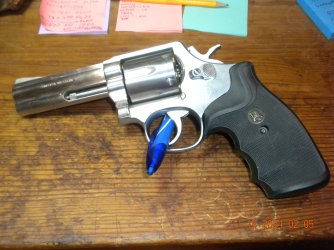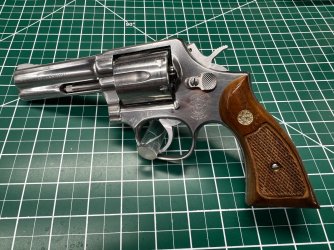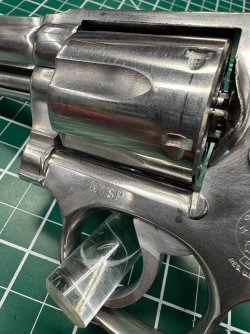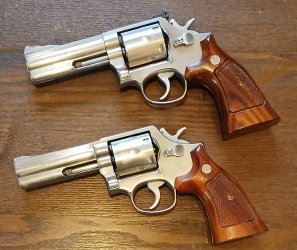I am unsure if this is the place to post this,if not point me to the place, pleae. I have a S&W 681 with 4" barrel. My brother wanted a glock 26 so I bought and traded him one. There are numerous markings on both sides of the butt, as well as, the serial number on the bottom. Some markings are duplicated at the yoke. I would like any information on the revolver nad it's markings. I am not an artist nor photographer, I hope you can decipher my efforts. I also have a Model 66, 5906, 4006 & 4566TSW. This is my first post, so I hope it goes well.
You are using an out of date browser. It may not display this or other websites correctly.
You should upgrade or use an alternative browser.
You should upgrade or use an alternative browser.
S&W Model 681
- Thread starter turnr848
- Start date
Register to hide this ad
Most of the markings found on S&W firearms are assembly numbers and inspector marks. Of course, there is a serial number, as required by BATFE, and there is usually a marking on the lower part of the left side of the grip frame to indicate what finish was applied or what material the revolver is made of. "N" indicated nickel plating. "S" could indicate blue or stainless. Revolvers returned for repair or custom work like an action tuning would receive a star and a month and two digit year date to indicate when the work was done. If a revolver is returned for a refinish, then it would receiver a "NS" or "NP" stamping.
I once had a 681. Even with the fixed sights, I was lucky enough to get ammo it shot point-of-aim.
You'll enjoy shooting yours. L-frames with wadcutters in them are like shooting a .22 revolver.
You'll enjoy shooting yours. L-frames with wadcutters in them are like shooting a .22 revolver.
SAFireman
Member
Nothing out of the ordinary there.....the marks on the frame are from fitters and inspectors at the S&W plant.
Rakkasan13F
Member
First welcome to the Forum. Others have answered your questions look like. That is a GREAT revolver. Shoot it and enjoy it and DO NOT sell it as you will likely not find another easily. I missed out on acquiring one and have kicked myself since.
Venom6
Member
The L-frames were S&W's response to the issue of K-frames not standing up well to a steady diet of full-house .357 magnums. When Bill Jordan and others encouraged Smith to bring out a K-frame in .357 the idea was to practice with .38's and reserve the magnums for zeroing and duty. Towards the end of the revolver era in law enforcement more agencies adopted the philosophy of "train like you fight," and began to do so with magnum ammunition. This led to recurrent end shake issues with the K frames as well as a few split forcing cones and other problems. The L-frame addressed these issues, and became the last and arguably the best of the duty revolvers before that industry stampeded to semi-autos. S&W offered them in various barrel lengths, with the 4" the most popular among most officers, in blue and stainless (with the latter being vastly more popular for ease of maintenance), and in fixed and adjustable sights (with the latter far outselling the former). IMHO the 681 is perhaps the most business-like, even sinister, of the whole marvelous family. I believe the 681 (and the even rarer 581) will increase in value faster than their adjustable-sight counterparts. As is so often the case in the firearms world the rarer items become more desirable to collectors; they are rarer because they didn't make as many; they didn't make as many because they weren't as popular. Rich irony. As an armorer for a thousand-man agency in the PNW in the 70's and 80's I can tell you we continually and regularly had to deal with end-shake and timing issues with K-frames, marvelous though they are, even shooting only .38's (though in fairness, we shot a lot). The L-frames, N-frames (and Ruger -Six series) rarely suffered in that way.
Tanners Owner
US Veteran
I have a 581 no dash, I bought from a neighbor. Great gun that I use in my ICORE games. Solid, good gun. Shoot it and enjoy it
Similar threads
- Locked
- Replies
- 3
- Views
- 1K
- Replies
- 10
- Views
- 637
- Locked
- Replies
- 0
- Views
- 301






